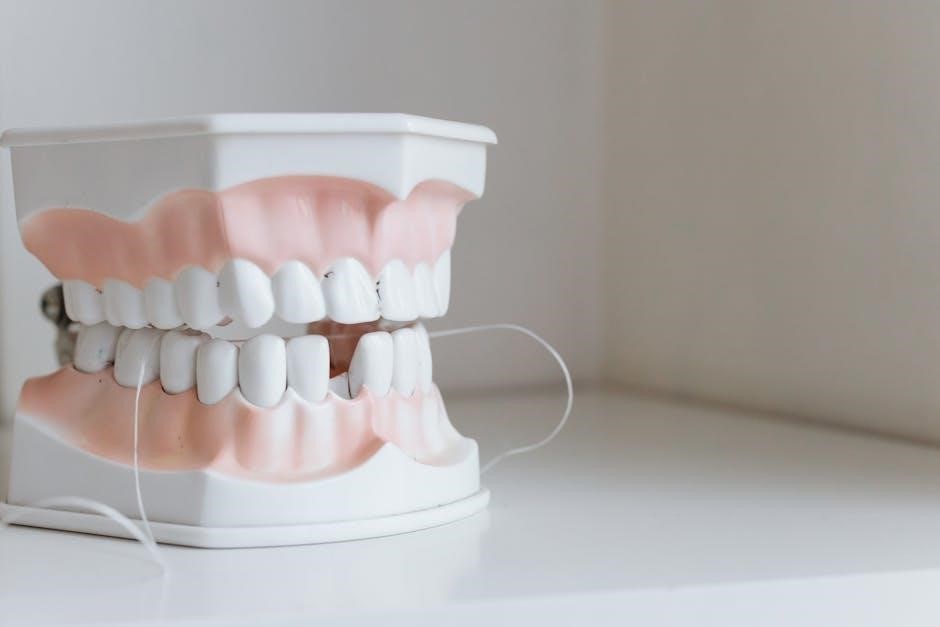Overview of “Anatomy & Physiology: An Integrative Approach”
This textbook provides a comprehensive exploration‚ seamlessly merging anatomical structure with physiological function. It employs an integrative methodology‚ enhancing understanding of the human body. The approach emphasizes the interconnectedness of systems‚ making learning more intuitive. The book is suitable for introductory level students.
Key Concepts Covered in the Textbook
The textbook “Anatomy & Physiology: An Integrative Approach” thoroughly covers fundamental concepts essential for understanding the human body. It delves into cellular biology‚ exploring cell structure‚ function‚ and processes like mitosis and meiosis. Histology‚ the study of tissues‚ receives significant attention‚ detailing the various tissue types and their roles in organ systems.
The skeletal system is examined‚ encompassing bone structure‚ joint classification‚ and skeletal movements. Muscular physiology covers muscle contraction‚ types of muscle tissue‚ and their involvement in body movement and posture. The nervous system is extensively explored‚ including neural communication‚ brain structure‚ and sensory perception. Cardiovascular physiology addresses heart function‚ blood circulation‚ and blood composition.
The respiratory system’s mechanics‚ gas exchange‚ and regulation of breathing are detailed. Digestive physiology covers the breakdown and absorption of nutrients. Urinary physiology explains kidney function‚ waste elimination‚ and fluid balance. Endocrine system concepts encompass hormone production and their regulatory effects on various bodily functions. Reproductive system anatomy and physiology are also discussed‚ covering reproductive processes and hormonal control.
Finally‚ immunological principles are explored‚ focusing on immune responses and defense mechanisms. These key concepts offer a comprehensive foundation for understanding the integrative workings of the human body.
Michael McKinley‚ Valerie O’Loughlin‚ and Theresa Bidle as Authors
Michael McKinley‚ Valerie O’Loughlin‚ and Theresa Bidle are the esteemed authors behind “Anatomy & Physiology: An Integrative Approach‚” a leading textbook in the field. Michael McKinley brings extensive expertise in human anatomy and physiology‚ contributing to the textbook’s clear and comprehensive explanations of complex concepts. His background ensures the accuracy and depth of the anatomical content‚ making it accessible to students.
Valerie O’Loughlin enhances the textbook with her knowledge of physiology and her skill in pedagogical design. Her contributions ensure the physiological processes are explained in an understandable manner‚ integrating them seamlessly with the anatomical information. O’Loughlin’s focus on student learning helps make the textbook engaging and effective.
Theresa Bidle completes the authorial team with her background in biology and her commitment to innovative teaching methods. She helps integrate various learning tools and resources into the textbook‚ such as interactive figures and animations. Bidle’s work ensures the textbook caters to diverse learning styles‚ promoting a deeper understanding of anatomy and physiology.
Together‚ McKinley‚ O’Loughlin‚ and Bidle create a textbook that not only presents accurate and detailed information but also fosters an integrative and engaging learning experience for students of anatomy and physiology.

Availability of PDF Downloads and Editions
The textbook “Anatomy & Physiology: An Integrative Approach” is available in various editions‚ often accessible as PDF downloads. These digital versions offer convenience and portability. Availability may vary‚ and accessing them ethically is crucial‚ respecting copyright laws.
Free PDF Options and Where to Find Them
Finding free PDF versions of “Anatomy & Physiology: An Integrative Approach” requires careful navigation of online resources. Some websites offer free downloads‚ often requiring account creation. Z-Library is mentioned as a source for downloading the book‚ although ethical considerations should always be paramount.
Legitimate avenues for accessing free PDFs include library websites‚ which may offer digital lending of the textbook. Additionally‚ some educational institutions provide students with access to digital textbooks through their online learning platforms;
It is essential to exercise caution when downloading PDFs from unofficial sources‚ as these may contain malware or violate copyright laws. Always verify the legitimacy of the source before downloading any files.
Keep in mind that older editions of the textbook may be available as free PDFs‚ while newer editions are typically protected by copyright. Exploring open educational resources (OER) repositories can also lead to freely available anatomy and physiology materials that complement the textbook.
Remember that respecting intellectual property rights is crucial. If a free PDF is not legitimately available‚ consider purchasing the textbook or accessing it through a library.
Differences Between Editions (e.g.‚ 3rd‚ 4th)
Successive editions of “Anatomy & Physiology: An Integrative Approach” incorporate updated research‚ refined content‚ and enhanced pedagogical features. The 4th edition‚ for example‚ is likely to include the latest scientific findings‚ revised illustrations‚ and improved interactive elements compared to the 3rd edition.
Significant differences may also exist in the organization and presentation of material. Later editions often streamline content for clarity and address feedback from instructors and students. Interactive figures‚ animations‚ and audio components may be enhanced or added in newer versions.
Furthermore‚ the accompanying online resources‚ such as test banks and solutions manuals‚ are typically updated to align with the current edition. Page numbers and chapter arrangements can vary between editions‚ potentially causing confusion if using older study materials.
Students should consult their course syllabus to determine the required edition. While older editions may cover similar core concepts‚ they may lack crucial updates and features essential for exam preparation. Always prioritize using the edition specified by the instructor.
Consider the specific needs and learning preferences when choosing an edition. Newer editions often provide a more comprehensive and engaging learning experience.

Integrative Approach to Anatomy and Physiology
The integrative approach to anatomy and physiology emphasizes the interconnectedness of the human body’s systems. Rather than studying each system in isolation‚ this method highlights how they work together to maintain homeostasis and overall function. This approach facilitates a deeper understanding of complex physiological processes.
By integrating anatomical structure with physiological function‚ students can better grasp how the body’s form supports its function. For example‚ understanding the structure of the heart is directly linked to comprehending its role in circulating blood. This holistic perspective promotes critical thinking and problem-solving skills.
The integrative approach encourages students to think about the bigger picture. It shows how seemingly disparate concepts are related. This methodology moves beyond rote memorization‚ fostering a more meaningful and lasting understanding of the subject matter.
This approach also makes learning more engaging and relevant. Students are better able to appreciate the complexity and elegance of the human body. The integrative method prepares students for future studies in healthcare and related fields. It provides a solid foundation for understanding clinical applications and real-world scenarios.
Ultimately‚ this approach cultivates a more profound and interconnected understanding of the human body.
Textbook Features: Interactive Figures‚ Audio‚ and Animations
This textbook enhances learning through a variety of interactive features. These include interactive figures‚ audio components‚ and animations. These elements are designed to engage students and improve comprehension of complex concepts. The interactive figures allow students to explore anatomical structures in detail. They can rotate‚ zoom‚ and dissect virtual models‚ providing a hands-on learning experience.
Audio components‚ such as heart sounds‚ offer an auditory dimension to the material. These sounds help students distinguish between normal and abnormal physiological states. Animations bring physiological processes to life‚ illustrating mechanisms that are difficult to visualize through static images. For example‚ animations can demonstrate muscle contraction‚ nerve impulse transmission‚ and blood flow dynamics.
These interactive features cater to diverse learning styles. Visual learners benefit from the figures and animations‚ while auditory learners appreciate the audio components. The combination of these elements creates a multi-sensory learning experience. This reinforces understanding and retention.
These tools are also accessible online‚ allowing students to learn at their own pace and review material as needed. The integration of technology enhances the educational value of the textbook. It makes learning more engaging‚ effective‚ and enjoyable for students.

Use as a Study Aid: Test Banks and Solutions
To maximize learning‚ this textbook comes with valuable study aids‚ including test banks and solutions. Test banks provide a comprehensive collection of questions covering all chapters. These questions are designed to assess understanding and retention of key concepts. They mimic the format of exams‚ helping students prepare effectively. By practicing with these questions‚ students can identify areas where they need further review.
Solutions are also available‚ offering detailed explanations for each question. These solutions not only provide the correct answer but also explain the reasoning behind it. This helps students understand the underlying principles and avoid common mistakes. The solutions are a valuable resource for self-assessment and learning from errors.
Together‚ the test banks and solutions create a powerful study tool. Students can use the test banks to assess their knowledge and the solutions to deepen their understanding. This iterative process of testing and review promotes active learning and improves exam performance. The availability of these resources makes the textbook an effective tool for self-study and exam preparation.
It’s crucial to verify the legitimacy of the source when accessing test banks and solutions online.
How to Access the Book Online
Accessing the textbook online often requires a digital or eTextbook ISBN. Online access may involve a platform that offers options to borrow or download the book. Creating an account might be necessary for full access to the content.
Creating a Free Account for Access
Many platforms offering online access to “Anatomy & Physiology: An Integrative Approach” require users to create a free account. This account often serves as a gateway to various resources‚ including the textbook itself‚ interactive figures‚ audio content‚ and animations designed to enhance the learning experience. The registration process typically involves providing basic information such as name‚ email address‚ and a chosen password.
By creating a free account‚ students gain access to a wealth of supplementary materials that complement the textbook content. These materials may include interactive quizzes‚ self-assessment questions‚ and other tools aimed at reinforcing understanding and promoting active learning. Additionally‚ some platforms offer the ability to track progress and receive personalized feedback‚ further enhancing the educational experience.
It is important to note that while creating an account may grant access to a significant portion of the textbook content and related resources‚ certain features or materials may require a paid subscription or purchase. Users should carefully review the terms and conditions associated with the account to fully understand the extent of access provided and any potential costs involved.
Some platforms might offer a free trial period‚ allowing users to explore the full range of features and content before committing to a subscription. This can be a valuable opportunity to assess the platform’s suitability and determine whether it meets individual learning needs and preferences.

Ethical Considerations when Downloading PDFs
Downloading PDFs of textbooks‚ including “Anatomy & Physiology: An Integrative Approach‚” raises several ethical considerations. Copyright laws protect intellectual property‚ granting authors and publishers exclusive rights to distribute and reproduce their work. Unauthorized downloading of copyrighted material constitutes a violation of these rights‚ potentially leading to legal consequences.
Furthermore‚ obtaining PDFs from unofficial sources often supports piracy‚ undermining the financial viability of authors‚ publishers‚ and the educational ecosystem. The creation of high-quality textbooks requires significant investment in research‚ writing‚ editing‚ and production. When individuals download pirated copies‚ they deprive creators of fair compensation and discourage future investment in educational resources.
Moreover‚ PDFs acquired from dubious sources may contain malware or viruses‚ posing a security risk to users’ devices and personal information. It is crucial to exercise caution and only download PDFs from reputable platforms or authorized distributors.
Ethical alternatives to unauthorized downloading include purchasing the textbook‚ borrowing it from a library‚ or accessing it through legitimate online platforms with subscription-based models. By respecting copyright laws and supporting ethical practices‚ students and educators contribute to a sustainable and vibrant educational environment that benefits all stakeholders.
Remember that academic integrity includes respecting intellectual property rights and avoiding plagiarism‚ which extends to the unauthorized use of copyrighted materials.

